Locked Down: Information Security for Lawyers
 By Sharon D. Nelson, David G. Ries & John W. Simek (Chicago, IL: ABA Law Practice Management Section, 2011). 306 pgs. $50.37 (for 12/30/12 release), at www.amazon.com.
By Sharon D. Nelson, David G. Ries & John W. Simek (Chicago, IL: ABA Law Practice Management Section, 2011). 306 pgs. $50.37 (for 12/30/12 release), at www.amazon.com.
Reviewed by Diane M. Welsh
The first chapter of this book may give you nightmares. The authors recognize that many lawyers are not tech-savvy and, as a rule, would rather avoid dealing with the issue of information security. Therefore, the authors attempt to scare lawyers into action. To do so, the authors explain the numerous risks to lawyers’ and law firms’ electronic information – actions taken for profit or revenge, from within and outside organizations, and by criminals from around the globe.
The first chapter immediately benefits readers with its list of essential steps that every law office should take to promote information security. The chapter explains why it is necessary to have a 12-character password for any secure system (and how to keep track of passwords without posting sticky notes near your computer) and a personal identification number (PIN) on your smart phone.
To further motivate attorneys to care about information security, the second chapter discusses attorneys’ ethical and legal duties to protect the security of client information, as well as state and federal laws that mandate the safekeeping of information, require disclosures of breaches, or both.
The remainder of the book includes practical information about security, written with an attorney audience in mind. The authors provide an overview of technical matters (including ones related to laptops, email, portable devices, remote access, cloud computing, and secure disposal) and raise awareness of important considerations for attorneys.
This is not a do-it-yourself manual for attorneys. Rather, the average reader will get a better general understanding of information security. This understanding should prove useful when talking to an information security consultant, as recommended by the authors, to help ensure your client files are secure.
Diane Welsh, American Univ. 1998, is a shareholder at von Briesen & Roper s.c., Madison, focusing on government and regulatory law, health law, and appellate litigation. She has resolved many privacy issues in both private practice and her previous job as chief legal counsel at the Wisconsin Department of Health Services.
The Seven Deadly Sins of Legal Writing
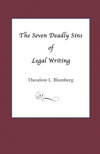 By Theodore L. Blumberg (Baltimore, MD: Archangul Foundation, 2008). 56 pgs. $7.95. Order, www.amazon.com.
By Theodore L. Blumberg (Baltimore, MD: Archangul Foundation, 2008). 56 pgs. $7.95. Order, www.amazon.com.
Reviewed by Joe Ahlers
Lawyers, says Theodore Blumberg, don’t write for people, they write for each other. In a field in which universal property – words – makes up the bulk of produced work, lawyers have a tendency to justify their professional existence by churning out a product of incomprehensible jargon draped in legalese as proof that they did, indeed, go to law school, regardless of how self-defeating this is in a world in which clients desire clear, uncomplicated advice on the law. Blumberg’s attempt to cure that ill is The Seven Deadly Sins of Legal Writing, a concise manual on how attorneys can connect with clients, impress judges, and improve the profession of law by avoiding common bad habits of legal composition.
Although Blumberg’s book won’t turn your writing from sandpaper to Shakespeare overnight, the goal is to avoid making basic errors in legal writing by re-grasping the important concepts, learned in every writing class from elementary school through law school, that somehow eventually slip through our memory. The book contains seven rules of writing that lawyers break because of ignorance, lack of education, or the profession’s preference for long-winded and pedantic prose over clear, concisely worded communication. Avoiding the egregious sins – passivity, abstraction, adverbiage, verbosity, redundancy, speaking footnotes, and negativity – will help make legal writing plain, clear, and thus useful to lawyers and nonlawyers. According to Blumberg, the point is not only to correct bad writing but also to convince the legal profession that “you are no less a lawyer for being understandable.”
Sins does have its weak points. For instance, Blumberg should have included more real-world examples to back up his opinions. While his chapters are peppered with writing that violates his rules, and the book’s goal – brevity – no doubt prevents including protracted foundation for each issue, Blumberg’s book is more overarching policy than illustration and will not provide much for the skimmer looking quickly for a citation.
Several passages also tactfully admonish law firms for poisoning the minds of new attorneys who come out of law school with impeccably honed skills and then are forced to cloud briefs with dense language to justify their work to clients and impress the judiciary. Whether or not this is true, the problem of bad legal writing afflicts lawyers regardless of age, gender, qualifications, and practice area, and is not confined to one category of novice attorneys.
Given the book’s purchase price of less than $10, it might be worthwhile to slip this thin folio into your next overnight bag or read it during a lunch break. No writer is perfect – I myself have both purposely and inadvertently committed a sin or two in writing this review – but Blumberg’s goal is to enhance scholarship over time, not all in one jolt. His essay can be revisited by those in need of a reminder of ways to improve their writing.
Joe Ahlers, U.W. 2011, is a judge advocate in the U.S. Air Force and chief of civil law at Altus AFB, Okla. He is on the editorial board of the Air Force Law Review.
Client Science: Advice for Lawyers on Counseling Clients through Bad News and Other Legal Realities
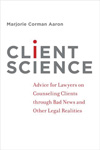 By Marjorie Corman Aaron (New York, NY: Oxford Univ. Press, 2012). 288 pgs. $33.01. Order, www.amazon.com.
By Marjorie Corman Aaron (New York, NY: Oxford Univ. Press, 2012). 288 pgs. $33.01. Order, www.amazon.com.
Reviewed by Kelly L. Lowery
Marjorie Corman Aaron, a professor and a mediator, arbitrator, and trainer in negotiation and dispute resolution, has produced a readable manual for one of the most important lawyering skills – counseling the client. The book begins by providing readers with practical advice on how to effectively communicate “bad news” and “other legal realities” to clients. Aaron does so while keeping in mind a lawyer’s obligation to fully inform the client and his or her desire to maintain a productive attorney-client relationship.
Drawing analogies to how doctors communicate bad news to patients, Aaron offers eight suggestions to lawyers for delivering bad news to clients: 1) be prepared; 2) arrange for private, comfortable surroundings and in-person conversations; 3) forecast the bad news up front, with sensitivity and compassion; 4) don’t delay communication of the bottom-line news; 5) be direct and scrupulously accurate; 6) provide information at a comfortable pace for the client, in simple language, without jargon; 7) attend to the client’s emotions; and 8) allow the client to absorb and come to terms with the information.
From there, the book is essentially divided into two parts. The first part focuses on what to say when counseling clients, and the second part is a how-to guide for communicating that information. Aaron gives readers specific suggestions for ordering, timing, phrasing, and method of explanation and technique adjustments for the lawyer’s voice and gesture. Without strong-arming readers into one specific communication methodology, the book gives lawyers a valuable opportunity to assess and improve their present communication styles and effectiveness. I suggest reading the first part of the book while reflecting on how the reader presents legal information to his or her clients before delving into the second part, which should aid the reader in developing his or her strategies for effective communication.
For me, the book’s main strength is that it provides advice for all lawyers regardless of specific area of practice. Aaron offers numerous examples throughout the book from a variety of areas of practice. In sum, Client Science: Advice for Lawyers on Counseling Clients through Bad News and Other Legal Realities is a useful read for lawyers of any experience level whose practices involve client counseling and who want to build and maintain strong attorney-client relationships, even when clients face difficult decisions or bad news for their case.
Kelly L. Lowery, Marquette 2010, practices plaintiff-side labor and employment law at Cross Law Firm S.C., Waukesha.
Lawyers Who Shaped Dane County: A History of the Practice of Law in the Madison Area
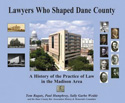 By Tom Ragatz, Paul Humphrey & Sally Garbo Wedde (Madison, WI: Dane County Bar Association, 2012). 140 pgs. $39.95, $32 (DCBA members). Order, www.dcba.net.
By Tom Ragatz, Paul Humphrey & Sally Garbo Wedde (Madison, WI: Dane County Bar Association, 2012). 140 pgs. $39.95, $32 (DCBA members). Order, www.dcba.net.
Reviewed by William Eich
Lawyers Who Shaped Dane County: A History of the Practice of Law in the Madison Area is an attractive and highly informative account of the county’s most memorable and influential lawyers, from 1838, when territorial attorney general Thomas Sutherland was the first to sign the county’s “Lawyer’s Roll,” to the mid 1980s. The authors not only went to great lengths to compile biographies of hundreds of attorneys but also located several photographs of Dane County Bar members dating from before the Civil War to 1977. (The hair on the heads of the lawyers in 1977 – including this writer’s – was nearly as long as that of their hirsute and bearded pre-1861 predecessors.)
The individual profiles are divided into three chronological groups, and each profile is accompanied by a photograph. The book then moves to a history of Dane County law firms, including the 19th- and early 20th-century roots of still-operating firms. In a list of firms in existence between 1880 and 1890, three caught my eye – Buell & Hanks, Buell & Parkins, and Buell & Lucas – and I wondered whether Mr. Buell may have been a little difficult to get along with in those days. But he obviously clicked with Mr. Lucas, because Buell & Lucas remained in existence well into the 1930s.
Also included is a chapter – one of the most interesting in the book – devoted to women lawyers. It begins with Lavinia Goodell, who was initially rejected for admission to the bar because she was a woman and was admitted, in 1875, only after the Wisconsin Legislature enacted a law stating that bar admission cannot be denied based solely on the applicant’s sex. There also are chapters on the history of the law school, the Dane County Bar Association, and the four courthouses that have served the county since 1850.
While the photographs and biographies will undoubtedly be of greatest interest to Dane County lawyers, 11 essays, some from historical sources and others contemporary – including one by Chief Justice Shirley Abrahamson and another by former Chief Justice Nathan Heffernan – will be of broader interest. The stories of some of the most notable lawyers should also have wide appeal.
For example, Silas Pinney was a prominent Madison lawyer (the firm he founded in 1851 continues today) who, as a Wisconsin Supreme Court Justice in the 1890s, collected and published the court’s opinions under the name Pinney’s Wisconsin Reports. This remains the Wisconsin courts’ official reporter today. Also of broad interest are the profiles of other lawyers whose accomplishments reached well beyond the county and even the state: lawyers such as U.S. Senator and 1924 Presidential candidate Robert M. La Follette, Chief Justice Abrahamson, Judge Thomas Fairchild of the Wisconsin Supreme Court and the Seventh Circuit Court of Appeals, and Richard Cates, special counsel to the Senate Judiciary Committee during the Watergate hearings.
So, although limited to one county’s lawyers, the book isn’t all nuts and bolts and local lists; there are many items of general interest – some of them quite fascinating – that will provide a good read even for readers outside Dane County.
William Eich, U.W. 1963, a former Dane County Circuit Court judge and chief judge of the Wisconsin Court of Appeals, maintains an arbitration and appellate consultation practice in Madison.
Restatement of the Law (Third) Trusts, Volume 4
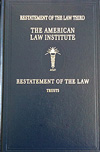 By the American Law Institute (Philadelphia, PA: 2012). 220 pgs. $131. Order, www.ali.org.
By the American Law Institute (Philadelphia, PA: 2012). 220 pgs. $131. Order, www.ali.org.
Reviewed by Douglas E. Baker
Is there anything more exciting than the arrival of a new volume of a restatement of the law? Especially a hardback copy, with its authoritative dark-blue binding and august gilded lettering, the smell of ink and glue, the crisp paper, and the thrill of holding black-letter law in one’s own hands?
Okay. Maybe most things are more exciting. After all, Restatement authors are not John Grisham or Scott Turow. The plots are thin and the characters poorly developed. The books lack the sparkle and panache of a PINNACLE® production. Still, all Restatement volumes are work worth looking into.
Mention the Restatements, and most lawyers likely have visions of law school tedium, recalling being force-fed legal theory. But Restatements have their place in the real-world practice of law. Although not primary authority, the case law and statutory tables in each volume might lead to controlling authority in a particular jurisdiction. More often they serve as powerful secondary authority, reliable guideposts through legally unsettled terrain. It’s rarely enough for a lawyer to be right – the court must be persuaded that the lawyer is right. Few sources are more persuasive than the venerable American Law Institute, publisher of the Restatements.
Volume 4 of the Restatement of Trusts (Third) closes out the latest restatement of the law of trusts. It deals with trust administration, more specifically, breaches of trust and the appropriate remedies, and addresses such issues as accounting methods, penalties for breach of fiduciary duties, standing, and the obligations of trustees, beneficiaries, and third parties. Included are not only broad, hornbook examples but also thorny issues that lurk within. For example, how many attorneys know whether the donation of a perpetual conservation easement creates a charitable trust relationship (§ 94, cmt. g(1)) or the conditions under which a Wisconsin court has interfered with a trustee’s discretionary trust-accounting power (In re Clarenbach’s Will, 23 Wis. 2d 71, 126 N.W.2d 614 (1964), cited in section 110)? Those who read this volume would know.
Like all Restatements, this book is meticulously organized, clearly written, and easily accessible. The index is well done, and tables abound – parallel tables to earlier Restatement volumes and tables of statutes (none from Wisconsin) and cases. Some lawyers might be familiar with the case tables from law school. Law student “gunners” were sometimes known to use them to prepare for class; they would go to the relevant Restatement index of cases and, if the case of the day was listed, they’d use the Restatement discussion to discern the legal point the case was selected to illustrate. Doing so made for a much better recitation if called upon (not that this reviewer would know that firsthand).
In short, it’s important that lawyers know this latest volume exists. Whether the book is worth buying is another question. It’s a lot like jumper cables: the time will come when you need them but although you can always find someone who has a set, sometimes it’s handier to have your own.
Douglas Baker, Creighton 1989, is an attorney editor with State Bar of Wisconsin PINNACLE.
The Second Bill of Rights and the New Federalist Papers
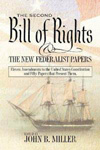 By John B. Miller (ed.) (Arlington, MA: TheNewFederalism LLC, 2012). 308 pgs. $19.95. Order, www.amazon.com.
By John B. Miller (ed.) (Arlington, MA: TheNewFederalism LLC, 2012). 308 pgs. $19.95. Order, www.amazon.com.
Reviewed by Heather Berlinski
In The Second Bill of Rights and the New Federalist Papers, four anonymous authors, in a series of 50 short essays, argue in favor of 11 new amendments to the U.S. Constitution. The essays argue that the amendments are necessary to protect and strengthen the Constitution and to restore the founders’ framework of limited government, individual freedom, and liberty. The book comes more than two centuries after ratification of the original Constitution but at a time when many citizens are again questioning the proper role of the federal government.
The book begins with the actual text of the proposed 11 amendments. For readers who would like to see how the proposed amendments would fit with the rest of the Constitution, the authors have incorporated the proposed amendments into the Constitution’s text, in the book’s appendix. I bookmarked these pages so that I could refer back to the actual versus proposed text while reading the essays.
The first half of the book contains 31 essays focusing on the “Liberty Rights Amendments.” These essays argue in favor of the first four proposed amendments, which would establish a broad constitutional definition of liberty rights and language to protect against encroachment on those rights by both federal and state governments. These 31 essays were redundant at times, but given that each is only a few pages long they are a quick read, and readers can skip around the essays in any order. The essays contrast the text of watershed U.S. Supreme Court cases with quotes from the original Federalist Papers.
The book’s second half focuses on proposed amendments five through 11. Given that each of these amendments concern subjects less dense than liberty rights and due process, the second half is a much faster read, with just one or two essays on each proposed amendment. These amendments cover both small policy changes, such as moving the fiscal year so that the President’s budget is released before the election, and large changes, such as eliminating the income, estate, and gift taxes in favor of a consumption tax. The authors freely acknowledge that the suggested amendments are unlikely to pass in their entirety but are intended instead to spark debate and encourage a national discussion of how to restore individual rights into the Constitution.
I recommend this book for readers who are interested in constitutional history and interpretation because it presents an interesting intellectual debate as to whether the Constitution is in need of reform and, if so, what reforms are necessary or could be supported by the public at large. With many people beginning to question whether the country is engaged in a “Constitutional crisis,” this book comes at an opportune time to reexamine our Constitution’s foundational principles and explore whether changes are necessary.
Heather Berlinski, Marquette 2011, is a government affairs associate with The Kammer Group, a governmental relations firm in Madison.
